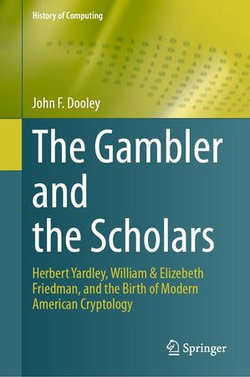
-
Books
-
Education
-
eBooks
-
Audio Books
-
Film & TV
-
Calendars, Diaries & Stationery
-
Giftshop

In May 1917, William and Elizebeth Friedman were asked by the U.S. Army to begin training officers in cryptanalysis and to decrypt intercepted German diplomatic and military communications. In June 1917, Herbert Yardley convinced the new head of the Army’s Military Intelligence Division to create a… more
In May 1917, William and Elizebeth Friedman were asked by the U.S. Army to begin training officers in cryptanalysis and to decrypt intercepted German diplomatic and military communications. In June 1917, Herbert Yardley convinced the new head of the Army’s Military Intelligence Division to create a code and cipher section for the Army with himself as its head.
These two seminal events were the beginning of modern American cryptology, the growth of which culminated 35 years later with the creation of the National Security Agency. Each running their own cryptologic agencies in the 1920s, the Friedman-Yardley relationship was shattered after Yardley published a tell-all book about his time in military intelligence. Yet in the end, the work they all started in 1917 led directly to the modern American intelligence community. As they got older, they became increasingly irrelevant in the burgeoning American cryptologic fraternity.
Topics and features:
* Examines the lives of three remarkable and pioneering cryptologists
* Offers fascinating insights into spies, codes and ciphers, rumrunners, poker, and military history
* Sheds new light on interesting parts of the cryptologists’ careers—especially Elizebeth Friedman, whose work during World War II has just begun to be explored
* Recounts several good stories, i.e., What if the Friedmans had gone to work for Herbert Yardley in his new Cipher Bureau in 1919? What if Yardley had moved back to Washington to work for William Friedman a decade later?
This enjoyable book has wide appeal for: general readers interested in the evolution of American cryptology, American historians (particularly of World War I, the inter-war period, and World War II signals intelligence), and historians of—and general readers interested in—American military intelligence. It also can be used as an auxiliary text or recommended reading in introductory or survey courses in history or on the related topics.
lessThis item is delivered digitally
Thanks for reviewing The Gambler and the Scholars. We will process your review. Accepted reviews will be posted within 3-7 business days.
Be the first to know, stay up to date with what's trending and get staff picks in your inbox with our newsletter


Public: Allow anyone to view or shop your List
Private: No one can view or shop your List
We have kept your A&R details for your new Angus & Robertson account
We also noticed that you have previously shopped at Bookworld. Would you like us to keep your Bookworld order history?
We also noticed that you have an account on Bookworld. Would you like us to keep your Bookworld details, including delivery addresses, order history and citizenship information?
Share This eBook